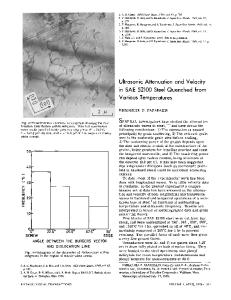An Investigation of the Creep of Ni 3 Al(B, Hf) Single Crystals at Intermediate Temperatures
- PDF / 955,480 Bytes
- 6 Pages / 420.48 x 639 pts Page_size
- 97 Downloads / 361 Views
AN INVESTIGATION OF THE CREEP OF Ni 3 AI(B,Hf) SINGLE CRYSTALS AT INTERMEDIATE TEMPERATURES K.J. Hemker and W.D. Nix Department of Materials Science and Engineering, Stanford University, Stanford CA, 94305
Abstract This study was undertakento characterizethe intermediatetemperature creepproperties of Ni3 Al. Itfocuses on the mechanisms controllingcreep deformation and their relationshipto the anomalous yielding behavior of this alloy. Constantstress creep tests were conductedfor temperatures between 713-973 K, and the following observations were made. The creep curves exhibited two distinct regions. Primary creep was followed by inverse creep. Specimens cooled under constant stress strained an additional 20% during cooling. Temperature drop experiments indicate that Ni3 Al is weakened by the addition of creep
deformation.
Glide on the primaryoctahedralplane appearsto be exhausted duringprimary creep. Slip trace andTEM studies indicate that inverse creep is controlled by slip on the cube cross slip plane and a secondary octahedralplane. Primary octahedralslip is observed in the specimens thatare cooled and deformed under constantstress.
1. INTRODUCTION The yield strength anomaly of Ni 3 A1 has been studied extensively. The factors contributing to the increase in yield strength with temperature have been identified and are reviewed by Pope and Ezz [1]. By comparison, the factors controlling the creep deformation of Ni3 A1 are still largely unknown. Nicholls and Rawlings [2] reported that there are two independent mechanisms controlling creep deformation of Ni3 A1 in the temperature range of 813 - 1203 K and that the transition between the two coincides with the temperature (Tp) at which the yield strength reaches a peak. It is known that Tp corresponds to the onset of primary cube slip [3,4,5]. Thus, it seems reasonable to assume that high temperature creep is related to primary cube slip while intermediate temperature creep is related to the anomalous yielding behavior of Ni 3 A1. The present study concentrates on creep at intermediate temperatures and on the relationship between creep and the anomalous yielding behavior of this alloy. Nicholls and Rawlings [2] have reported steady state creep rates for Ni 3 A1 (10% Fe) at temperatures less than Tp, but subsequent studies by Schneibel and Horton [6] and Anton et al. [7] have indicated that steady state is not always attained during creep testing. These latter workers reported inverse creep curves for Ni3 AI(B,Hf). Also, subgrains were not observed in the crept specimens of Ni 3 A1 [6,7]. Because subgrains were not observed and because the test temperatures used in these studies were below half the melting temperature (Tm) for Ni3 AI, it is expected that processes other than diffusion might be controlling the creep rate [8]. It follows that dislocations mechanics must play a very important role in the creep of Ni3 AI at these intermediate temperatures. The data of Nicholls and Rawlings [2] suggest that, at intermediate temperatures, the creep strength of Ni 3 Al
Data Loading...











